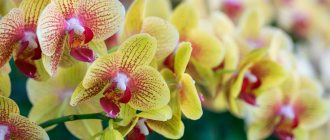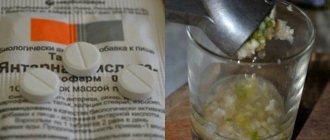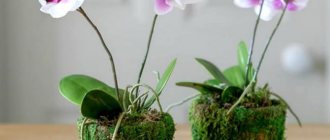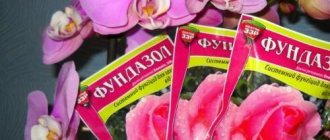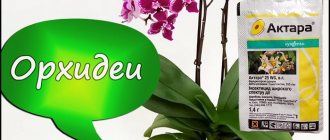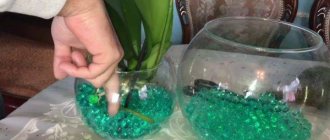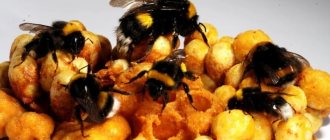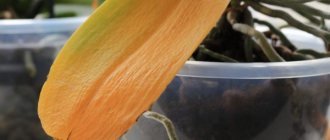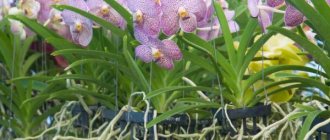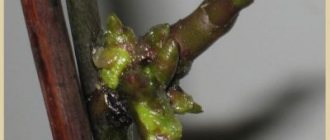The orchid has lush blooms. Therefore, the owners of this beautiful flower try to stimulate the forcing of the peduncle and preserve it so that the buds open. But the capricious exotic plant does not always want to bloom and can sit in a pot for a long time, producing new leaves. How to stimulate an orchid to bloom?
Artificial stimulation of an orchid
Artificial stimulation in growing orchids is used to provoke the plant to bloom.
No matter how ideal the conditions for their cultivation may be, no matter how competently and clearly the feeding system is thought out, there are times when orchids need to be pushed to begin flowering.
Artificial stimulants are used for this.
Main types of plant growth stimulants
Auxins
These are widely known phytohormones that enhance the flow of water and nutrients dissolved in it into plant cells and contribute to their proper redistribution. In the plant, it is produced and accumulated in the cells of the root system, at the apical points of the plant, allowing it to actively grow.
When there is a lack of lighting, treatment with this hormone promotes “stretching” on the darkened side , preventing unnecessary, aesthetically imperfect bends.
The influence of auxins.
Important! Auxins should be used with great caution, observing very precisely the proportions and dosage. The slightest mistake can lead to the opposite effect and even inhibit the development of the orchid.
Gibberellins
Gibberellins are plant hormones that regulate plant growth, stem elongation, seed germination, and flowering . This hormone is located in dormant kidneys, therefore, when its concentration is increased artificially, their development is stimulated.
Thus, when an orchid is treated with gibberellin, the development of the flower bud, the formation of buds and flowers is accelerated; they can become larger and display brighter colors. Not only does the flower develop, but the growth of leaves and peduncles also increases.
Along with the active development of the above-ground part, gibberlin provokes the development of cells of the root system , which is important, given that many orchids have a photosynthetic root system and with an increase in the total photosynthetic area, the growth of the plant as a whole is naturally activated.
The influence of gibberellins.
Cytokinins
Cytokinins are another type of phytohormone, increasing the concentration of which in the plant:
- stimulates the formation of buds, and, accordingly, the activity of flower formation;
- promotes the opening of stomata, that is, it activates the plant’s respiration process;
- provokes the growth of lateral buds in the presence of dominant apical growth.
They are successfully used for vegetative propagation of plants.
The influence of cytokinins.
Important! Cytokinins require great care when working. Personal protective equipment is required. Be sure to put the drug in a place inaccessible to children!
How can you feed orchids?
It is no longer a secret for experienced gardeners that fertilizers for orchids are included in a separate group by manufacturers. The reason is that these flowers need to be fed in a special way, not like other indoor plants. Firstly, orchids prefer a reduced concentration of fertilizers compared to other flower crops. Secondly, organic matter is strictly contraindicated for orchids, since it contains nitrogen in a volume that is harmful to them. And it’s somehow not entirely pleasant to use it indoors, even if you have the opportunity to purchase it.
It is also better to avoid folk remedies: they will not fully interact with either the plant itself or the substrate, since it is not a traditional soil mixture, but consists of bark, expanded clay and charcoal.
If you are a professional gardener, then you can “collect” fertilizer for orchids yourself, using monofertilizers for this purpose. But keep in mind that the standards in this case must be accurate, and it is quite difficult to measure dry fertilizer correctly.
In the spring, prepare a complex with NPK 10:10:10 or 16:16:16, but remember that the orchid should receive a very weak fertilizer solution - no more than 1.5-2 g of fertilizer per 1 liter of water.
During the budding period, remove nitrogen from the composition, and leave phosphorus and potassium. Superphosphate and potassium sulfate are suitable for this. Add microelements to every second feeding (the orchid needs boron, molybdenum, manganese and zinc most of all).
It is safer to use liquid complex fertilizers designed specifically for orchids. Usually, when developing them, all the features of this plant are taken into account. Successful examples include drugs such as Agricola for orchids and Agricola Aqua for orchids . Their combination is quite enough for year-round feeding, excluding the dormant period. However, there is one more mandatory point in caring for orchids that it is advisable to study.
Root formers
To enhance the development of the root system, when necessary, it is recommended to use root stimulants, such as:
- Kornevin;
- Embiko;
- Ribav-Extra.
The main component of all these drugs is the orchid growth hormone heteroauxin , which promotes accelerated growth and development of root cells.
Heteroauxin is added to all root-forming preparations.
In addition to it, fungicides are added to the preparations , preventing the development of pathogenic microflora, or a starting set of microelements, which ensures healthy, full-fledged cell growth.
When using Kornevin powder, it is recommended to dilute it with crushed activated carbon, which acts as an antiseptic and is used to prevent the occurrence of fungal and bacterial diseases of orchids.
Caring for the plant while using medications
After treating the plant with any root growth stimulator, it should be provided with favorable conditions. Depending on the condition of the plant, you need to choose a further method for germinating the root system: greenhouse or in the air. If the roots are completely absent, then the first option is a greenhouse (we talked in detail about how to resuscitate an orchid without roots here). If some of the roots are still present, then you can do without it. However, despite the method of germination of the root system, the following care is needed:
- Maintaining a comfortable temperature +23-25ºС.
- You need to choose a well-lit place to stay. However, diffused light is required.
- Humidity within 50-60%.
- Be sure to regularly ventilate the room.
- Water once a week; in between, the soil should dry out completely.
- Spray daily.
- It is worth regularly fertilizing with fertilizers based on potassium and phosphorus, once every 10-14 days.
Vitamin cocktails
Vitamins can be used as stimulators for the development of orchids , such as:
- thiamine – vitamin B1 , which increases the size of flowers, stimulates the development of the root system, and slows down the aging of the orchid;
- Niacin – vitamin B3, improves reproductive function, accelerates the onset of flowering. It is often used when it is necessary to revive a diseased plant;
- pyridoxine – vitamin B6 , improves adaptation after transplantation, used for flowers that are recovering from illness;
- cobalamin – vitamin B12 , stimulates photosynthesis, saturates cells with oxygen, normalizes plant growth after stress.
To prepare a vitamin cocktail, you need to mix two or more of these drugs and treat them.
Possible problems
Preparations for stimulating roots can bring not only benefits, but also harm the flower. You should not use a stimulant in the following cases:
- the orchid just survived the transplant;
- is in a state of flowering;
- the flower is sick or young.
On our portal you can get acquainted with the causes of such problems in orchids as falling flowers, the appearance of mold and plaque, wilting, yellowing and drying, and also learn how to help the plant in all these cases.
When working with a stimulant, do not forget to follow safety precautions, wear personal protective equipment, and follow the rules and dosage indicated on the packaging of the substance. After all, an excessive amount of the drug can lead to rotting of the roots.
These drugs are certainly a useful and necessary thing. Without them, it is almost impossible to carry out resuscitation measures. In cases where the orchid has completely or partially lost its root system. Chemicals also promote the reproduction process. However, it is important to strictly follow the instructions for use and not deviate from them, otherwise the consequences may be unexpected.
Brief overview of stimulants
Growth and development
Ferrovit
This drug enriches the plant with iron , which can increase the amount of oxygen supplied to the cells and activates the healthy growth of the plant.
Epin
Epin strengthens the plant's immunity , increases resistance to pathogenic organisms, and stimulates the development of buds and flowers.
Epin.
Augustine
The main active ingredient is chitosan , which promotes long-lasting bright flowering, active root growth and increased immunity of the orchid.
Tsitovit
Contains the most important microelements that stimulate the development of the orchid and activate full, abundant flowering, improves immunity, and brings the orchid out of the “frozen” state.
succinic acid
Succinic acid acts as a catalyst for those orchids that, for one reason or another, have stopped growing or stopped blooming, and also strengthens the immune system , removing the orchid from a state of stress.
Succinic acid is widely used in the resuscitation of orchids.
Vitalizer HB – 101
A very popular biostimulant that promotes the active development of buds, increasing their number, as well as promoting the formation of large, bright, numerous flowers .
Root growth
Kornevin
Activates the growth of cells of the root system , is used to resuscitate orchids whose roots have been lost as a result of infection with fungal microorganisms.
Cytokinin paste
Cytokinin ointment for growth activates the process of cell division, catalyzes the regeneration of plant tissues, and is often used for successful vegetative propagation of plants.
Cytokinin paste is also used for reproduction.
Maksim
The roots of orchids are treated with a solution of this drug when fungal diseases occur. It acts as an antiseptic and at the same time stimulates the development of new cells .
When and how to feed orchids
It is customary to fertilize these flowers all year round, with the exception of the dormant period, which for orchids does not always last the whole winter. However, from November to February, feeding is usually carried out no more than once a month, the rest of the time - with an interval of 14-15 days.
At the peak of the summer heat, when the daytime air temperature exceeds 25°C, the frequency of fertilizing is halved, and instead the orchids are often sprayed on the leaves with warm water or rinsed in the shower.
The dormant period for an orchid usually begins immediately after flowering ends. The peduncle dries out, it is cut off completely or only the healthy part is left and plant care is reduced to a minimum. The end of the dormant period is indicated by the appearance of new leaves and the growth of aerial roots. As a rule, this happens just at the end of winter, which means that it is time to resume intensive feeding.
You can fertilize an orchid in two ways: by leaves (foliar feeding) and at the root. In the second case, the plant is pre-moistened to protect its roots from burns.
Root feeding is suitable for completely healthy orchids that have long taken root. But if the flower is now sick, or has recently been transplanted and its roots are still not functioning well, use only foliar feeding.
After the liquid with fertilizer has drained into the pan, pour it out and repeat this action until the excess liquid has completely drained out of the orchid pot.
Root and foliar feeding should be alternated, but not carried out simultaneously.
